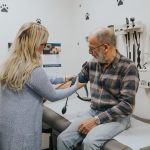I have two questions regarding the proposed continuity of care standard addition "7. A regulated member must not order a diagnostic test or make a referral request in another healthcare provider’s name."
In terms of ordering anatomic pathology diagnostic testing the terminology on our requisitions and clinical and lab information systems has varied over the years and has included in the primary requesting line "ordering physician, physician to act on results, requesting clinician to act on results and currently with the provincial connect care system being implemented authorizing provider" . With anatomic pathology it is not rare that the physician actually ordering/requesting the test is not the one physically obtaining the specimen/filling out the requisition and the physician responsible for acting on the results may be different from both of the physicians above. Because the clinical and lab information systems and corresponding requisitions do not allow for this clear distinction of physician roles, which from a continuity care point of view would be optimum, and we do not have the ability to change this (i.e the authorizing provider terminology built into connect care was designed from a U.S.A. perspective where insurance companies are trying to decide if they need to reimburse charges for diagnostic testing and will only cover testing authorized by a health care provider that is part of that insurance providers group) we are left with a situation that has risk of patient harm related to continuity of care problems. If for example according to the proposed CPSA standard the physician obtaining the biopsy and that is filling out the requisition has to list themselves as the "authorizing provider" even though they are not the ones that really requested the test and will not be following up on the results with the patient and may not even be in the country or contactable when potential critical results of that test arise, then a very real risk of patient harm may arise. This is the very scenario that in the past has lead to patient harm and which initially resulted in a change of our requisitions to have mandatory fields of "physician to act on results and tissue removed by" (i.e the tissue removed by person is responsible for the requisition and that would be contacted next if the physician listed as the one to act on results was contacted and stated they were not the correct person). However, with the new provincial information system only the authorizing provider is a mandatory field (there is no separate physician to act on result field) and if the physician who is doing the biopsy and filling out the requisition is not allowed to place the physician who is going to act on results in that field then we will run into scenarios like before where we cannot guarantee critical results will be able to given in a timely manner to the real person looking after the patient. So for my first question is how can a physician adhering to this proposed CPSA standard and restricted by forced mandatory fields and terminology on diagnostic anatomic pathology requisitions, which they cannot change, not create a scenario as listed above that can result in patient harm as has occurred in the past?
The second question is in regards to how the proposed standard is felt to work in the situation of "reflex diagnostic testing". For some tumors current protocols require reflex testing be done for two purposes 1)Screening for hereditary cancer syndromes (like Lynch Syndrome) 2)Expediting predictive and prognostic results which may affect patient treatment (i.e in some scenarios oncologists need the test results to determine the appropriate systemic/chemotherapy and as opposed to waiting to see the patient at first referral and then order the test themselves they want the sign out pathologists to reflexively order the tests upfront to save 1-2 weeks in delay to patient treatment (as some of the tests themselves take up to 3 weeks to perform and often chemotherapy by protocols should optimally be started within 4 weeks of diagnosis). The physician/pathologist ordering the reflex testing at time of diagnosis in these scenarios is not the physician who will be acting on results, never has contact with the patient and often does not know who the physician is that the patient will be referred to for treatment or who is going to followup on the results. Occasionally the physician ordering such reflex testing does know who the oncologist is that wants the test results and will be acting on them. In such a scenario given the restrictions of the lab information system and requisitions noted above it makes far more sense from a continuity of care scenario to list the oncologist as the authorizing provider to ensure they get the test results and are contacted first for critical results as opposed to the pathologist to be forced to put their own name as the authorizing provider when again they will never have contact with the patient or know how to best contact/locate the patient, will not be looking for the results as they do not change anything the pathologist would do with that patient's care/case and may not be around or even in the country when the test results from that reflex genetic or molecular testing is completed. So the second question is how does the CPSA feel the proposed standard should work in regards to reflex testing protocols that currently exist for the screening of hereditary cancer syndromes and predictive biomarker testing for oncology treatment purposes of some tumors?
CPSA’s office is closed from noon on Dec. 24, 2025, through Jan. 1, 2026, reopening at 8:15 a.m. on Jan. 2, 2026. For urgent requests unrelated to annual renewal, call 1-800-561-3899. For annual renewal and all other inquiries, email support@cpsa.ca and we will respond when our office reopens. More information
- Albertans
- Physicians & Physician Assistants
 Registration & SponsorshipApply to practise, become a sponsor & update practice details
Registration & SponsorshipApply to practise, become a sponsor & update practice details ComplaintsInfo about complaints, hearings & appeals
ComplaintsInfo about complaints, hearings & appeals CompetenceTools & support for physician competence
CompetenceTools & support for physician competence PrescribingPrescribing resources & TPP Alberta info
PrescribingPrescribing resources & TPP Alberta info Standards of PracticeExpectations of physician professionalism
Standards of PracticeExpectations of physician professionalism COVID-19 Info for PhysiciansGuidance & resources for physicians
COVID-19 Info for PhysiciansGuidance & resources for physicians
- Facilities & Clinics
- About CPSA
 GovernanceInfo about our Council, committees and governance policies
GovernanceInfo about our Council, committees and governance policies Equity in Health CareOur commitment to safe and equitable care
Equity in Health CareOur commitment to safe and equitable care Analytics, Innovation & ResearchEvidence-based medical regulation
Analytics, Innovation & ResearchEvidence-based medical regulation OpportunitiesCareer and contract opportunities
OpportunitiesCareer and contract opportunities Corporate ServicesFee schedules and other operations resources
Corporate ServicesFee schedules and other operations resources MessengerOur monthly newsletter
MessengerOur monthly newsletter Grants & AwardsRecognizing and supporting our community
Grants & AwardsRecognizing and supporting our community Contact UsWays to reach us, plus info for media
Contact UsWays to reach us, plus info for media
-
- Registration & Sponsorship
- Apply to Practise
- Apply for Independent Practice
- Apply for Physician Assistant Registration
- Apply for Limited Practice Registration
- Apply as a Medical Student, Resident or Fellow in Alberta
- Apply for Temporary/Courtesy Registration
- Apply for Academic Appointment on the Provisional Register
- English Language Proficiency
- Become a Sponsor
- Update or Renew my Practice
- Request my Certificate of Professional Conduct (CPC)
- Apply to Practise
- Complaints
- Competence
- Prescribing
- Standards of Practice
- COVID-19 Info for Physicians
- Registration & Sponsorship
-
- Accredited Facilities
- Medical Clinics






Comments for this post are now closed. If you would like to share your feedback on this topic, please email support@cpsa.ca.